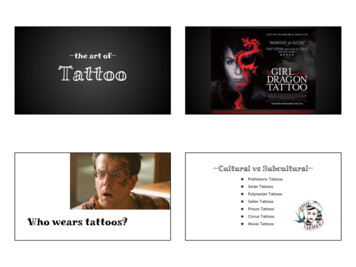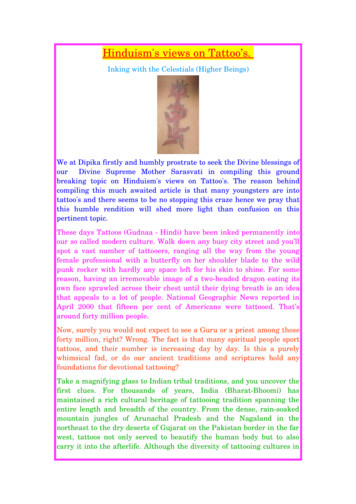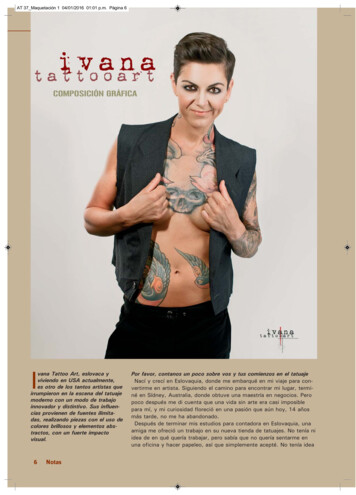
Transcription
the art of Tattoohttp://www.youtube.com/watch?feature player detailpage&v gEW1hgCmOiE#t 7 Cultural vs Subcultural Who wears tattoos? Prehistoric Tattoos Asian Tattoos Polynesian Tattoos Sailor Tattoos Prison Tattoos Circus Tattoos Movie Tattoos
The history of tattoo began over 5000 years ago and is as diverse asthe people who wear them. From the Polynesian word “ta” which means striking something andthe Tahitian word “tatau” which means to mark something. Bronze Age Tattoos are created by inserting coloured materials beneath the skin’s surface.In 1991, a five thousand year old tattooed man - “Ötzi the Iceman” made the headlines of newspapers all over the world when his frozenbody was discovered on a mountain between Austria and Italy. The first tattoos were probably created by accident. Someone had asmall wound, and rubbed it with a hand that was dirty with soot andashes from the fire. Once the wound had healed, they saw that amark stayed permanently.This is the best preserved corpse of that period ever found. The skinbears 57 tattoos, including a cross on the inside of the left knee, sixstraight lines 15 centimetres long above the kidneys and numerousparallel lines on the ankles. The positioning of the tattoo marks suggests that they were probablyapplied for therapeutic reasons (treatment of arthritis). Siberia (Pazyryk Culture) In 1948, north of the border between Russia and China, Russian archaeologists began excavating agroup of tombs, or kurgans, in the high Altai Mountains of Western and Southern Siberia.Mummies were found that date from around 2400 years ago. The tattoos on their bodies represent a variety of animals. The griffins and monsters are thoughtto have a magical significance but some elements are believed to be purely decorative. Altogetherthe tattoos are believed to reflect the status of the individual. In 1891, archaeologists discovered the mummified remains of Amunet, a priestess of the goddessHathor, at Thebes who lived some time between 2160 BC and 1994 BC. This female mummy displayed several lines and dots tattooed about her body - grouping dotsand/or dashes were aligned into abstract geometric patterns. This art form was restricted towomen only, and usually these women were associated with ritualistic practice. The Egyptians spread the practice of tattooing throughout the world. The pyramid-building thirdand fourth dynasties of Egypt developed international nations with Crete, Greece, Persia, andArabia. By 2000 BC the art of tattooing had stretched out all the way to Southeast Asia . Ancient Egypt
Japan (Hori) The Ainu (Western Asian nomads) brought the art of tattoo with them as they moved to Japan. The earliest evidence of tattooing in Japan is found in the form of clay figurines which have facespainted or engraved to represent tattoo marks. The oldest figurines of this kind have beenrecovered from tombs dated 3000 BC or older. These figurines served as stand-ins for living individuals who symbolically accompanied the deadon their journey into the unknown. The Japanese were interested in the art mostly for its decorative attributes, as opposed tomagical ones. “Hori” - Japanese tattoo artists - were the undisputed masters. Their use of colour,perspective, and imaginative design gave the practice a whole new angle. The classic Japanese tattoo is a full body suit. From Southern China the practice of tattoo spread along the silk route. China Thailand (Sak Yant) A “Sak Yant” is a magic tattoo which bestows mystical powers. This Sak Yant magic tattoo isnormally given by a Buddhist Monk or Brahmin Priest but a Sak Yant can also be performed by alayman. Of the Countries in Asia where Sak Yant tattooing is carried out, Thailand is by far the countrywith the highest number of devotees. The Thai word “Sak” means to tattoo and a “Yant” is asacred design that incorporates Buddhist prayers called Mantras or Katas that will invokesupernatural powers. Polynesia (Samoa, Hawaii, Tahiti) In Pacific cultures tattooing has a huge historic significance. Polynesian tattooing isconsidered the most intricate and skillful tattooing of the ancient world. Polynesian peoples believe that a person's “mana”, their spiritual power or life force, isdisplayed through their tattoo. The vast majority of what we know today about these ancient arts has been passed downthrough legends, songs, and ritual ceremonies. Elaborate geometrical designs were oftenadded to, renewed, and embellished throughout the life of the individual until they coveredthe entire body. In Samoa, the tradition of applying tattoo, or “tatau”, by hand has long been defined by rankand title, with chiefs and their assistants, descending from notable families in the properbirth order. The tattooing ceremonies for young chiefs, typically conducted at the onset of puberty, wereelaborate affairs and were a key part of their ascendance to a leadership role. Indonesia (Borneo) Borneo is one of the few places in the world where traditional tribal tattooing is still practicedtoday just as it has been for thousands of years. Until recently many of the inland tribes hadlittle contact with the outside world. As a result, they have preserved many aspects of theirtraditional way of life, including tattooing. Borneo designs have gone all around the world to form the basis of what the Western people ure player detailpage&v BqGQa7HB 1g
The permanent marks left by the tattoo artists would forever celebrate their endurance anddedication to cultural traditions. The first Europeans who set foot on Samoan soil were members of a 1787 french expedition.They got a closer look at the natives and reported that “the men have their thighs painted ortattooed in such a way that one would think them clothed, although they are almost naked”. The mythological origins of Samoan tattooing and the extraordinary cross-cultural history oftatau has been transported to the migrant communities of New Zealand, and laterdisseminated into various international subcultures from Auckland to the Netherlands. The Hawaiian people had their traditional tattoo art, known as “kakau”. It served them notonly for ornamentation and distinction, but to guard their health and spiritual well-being. The most heavily tattooed members of the tribe would be the royal family, followed by othercourt officials and persons who were in the royal family by marriage. The designs were monochromatic, tattooed in black against brown skin. The patterns andlayout were strongly geometric and there were many shapes and symbols which representedthe natural island world: stones, waves, fish, sharks, turtles, rain, sun, birds. Intricate patterns, mimicking woven reeds or other natural forms, graced men's arms,legs, torso and face. Women were generally tattooed on the hand, fingers, wrists andsometimes on their tongue. Queen Kamamalu had a tattoo applied to her tongue as an expression of her deep griefwhen her mother-in-law died in the 1820s. Missionary William Ellis watched the procedure,commenting to the queen that she must be undergoing great pain. Traditionally, tattooing in Tahiti has always been a privilege of the more eminent socialclasses. Social ranking allowed tattoos corresponding to the wearer's position in thecommunity. Men often had tattoos all over their body, including on the neck and ears. Only the facewas left untattooed except for the occasional warrior or priest who might wear a specialemblem on his forehead or lips. In ancient Tahitian society all women were tattooed. Young girls were tattooed at a veryyoung age with marks on the inside of their arms to show that they were free from foodtabus. Until that time they could only accept food prepared by their mothers - no-one else.There are no illustrations of these marks, just a few descriptions. Young women were againtattooed and they began to wear clothes as they reached puberty. New Zealand (Maori) The Maori of New Zealand created one of the most impressive cultures of all Polynesia. Theirtattoo reflected their refined artistry, using their woodcarving skills to carve skin. Traditional Maori tattoos are known in the Maori language as “ta moko”. Literally the wordsta moko translate as to strike or to tap. The term refers to the process of tattooing in theMaori traditions. Moko is the tattoo design itself – the finished product. The Maori tattoo consists of bold spiral designs covering the face, the buttocks and the legs ofthe Maori men. Maori women were usually tattooed on the lips and chin and in some cases onthe neck and the back. The full-face moko was a mark of distinction, which communicated status, lines of descent andtribal affiliations. It recalled the wearer's exploits in war and other great events. Tattoo art was an important part of the Maori culture – in fact, people without tattoos wereconsidered to be without status or worth. Ta moko has a sacred significance – the Maori tattoo design itself, and the long and painfulprocess of acquiring the tattoo.http://www.youtube.com/watch?feature player embedded&v BbC65PpBojM
Tattooing by making incisions with a chisel was a painful process, but traditional Maoritattoos were meant to be more than decorative – they were a show of strength, courageand status. Maori tattooing was done with bone chisels and knives - “uhi” - which were made fromalbatross bone, either smooth or serrated, and the ink was applied by means of incisions. Maori tattooing would usually start at adolescence, and was used to celebrate importantevents throughout life. The first tattoo marked the transition from childhood to adulthoodand was done during a series of rites and rituals, with music, chants and fasting. The tattoo ink for the body color was made from an organism that is half vegetable, halfcaterpillar (the caterpillar is infected by a certain kind of fungus that starts growing outof its head, killing the caterpillar). The darker, black tattoo ink used for the face wasmade of burned wood. Maori symbolism has its origin in their deep spiritual connection with nature. Moko is avisual language and all symbols have meaning, usually a tribal/ancestral link that tells thebackground and stories of the wearer. Polynesia Mutiny on the Bounty mu·ti·nyHMS Bounty was aBritish Royal Navyship. On 28 April,[ myt'nee ]1.rebellion against legal authority: a rebellion against legalauthority, especially by soldiers or sailors refusing to obeyorders and, often, attacking their officers2.participate in mutiny: to take part in a rebellion against legalauthority1789 a mutiny wasled by FletcherChristian againsttheir captainWilliam Bligh off thehttp://www.youtube.com/watch?v RSifu23RpYEIsland of Tahiti.SYNONYMS: rebellion, revolt, sedition, uprising, insubordination,defiance, recalcitrance, revolution, riot, insurgence, insurrection
The HMS Bounty reached Tahiti on October 26, 1788, after ten months at sea. Bligh and his crew spent five months in Tahiti, collecting and preparing breadfruitplants for transport. Bligh allowed the crew to live ashore and care for the potted breadfruit plants, andthey became socialized to the customs and culture of the Tahitians. Many of the seamen had themselves tattooed in native fashion. Master's Mate and Acting Lieutenant Fletcher Christian married Maimiti, a Tahitianwoman. Other warrant officers and seamen of the Bounty were also said to haveformed connections with native women. The mutineers set Bligh afloat in a small boat with eighteen crew members loyal to him.To avoid detection and prevent desertion, the mutineers then variously settled onPitcairn Island or on Tahiti and burned the Bounty. Descendants of some of the mutineers and Tahitians still live on Pitcairn. The mutinyhas been commemorated in books, films, and songs. Navy & Sailor Tattoos Tattooing on sailors dates back as far as the 1700s when British explorer CaptainJames Cook came across the natives of the South Pacific, and his crew decided toget tattoos as souvenirs of their visit. The culture among sailors is undoubtedly rich in traditions. Sailors have thecustom of getting tattoos as an expression of important events or experiencessuch as travels, achievements, naval hierarchy, rank, status, membership, and astalismans to protect sailors from drowning far from home.Symbolic Significance Navy & Sailor Tattoos Sailors on their ships returned home with tattoos usually of a very basic style thatonly used a minimum amount of detail making the tattoos look quite twodimensional and flat. This often gave a cartoonish feeling and typical motifs would be flowers, hearts,mermaids, ships, anchors, snakes, birds, and names. Norman Collins, better known as Sailor Jerry, was a tattoo artist during theSecond World War in Honolulu, Hawaii. Sailor Jerry is the man most noted formaking tattoos an art in America rather than just a permanent souvenir fordrunken sailors. A pig and a rooster were tattooed on either the ankles, calves or top of the feet,to prevent a sailor from drowning. These animals were originally carried on mostships in wooden crates. When a ship went down the crates would float and thencatch currents and wash ashore with the other debris from the ship, making thepigs and roosters often the only souls to survive a shipwreck. A tattoo of a pig onthe left knee and a rooster on the right foot signified "Pig on the knee, safety atsea. A cock on the right, never lose a fight." Tattoos of pigs and chickens were to make sure sailors always had their ham andeggs so that they never went hungry.
A sailor would get a swallow tattoo for every 5000 miles he had sailed (aswallow will always find its way home). Anchor tattoo for crossing the Atlantic. The anchor usually noted that thesailor was in the merchant marine. A sparrow tattoo for every 5000 or 50,000 nautical miles traveled. Full rigged ship tattoo for sailing around Cape Horn. A turtle standing on its back legs (shellback) for crossing the
Maori traditions. Moko is the tattoo design itself – the finished product. The Maori tattoo consists of bold spiral designs covering the face, the buttocks and











